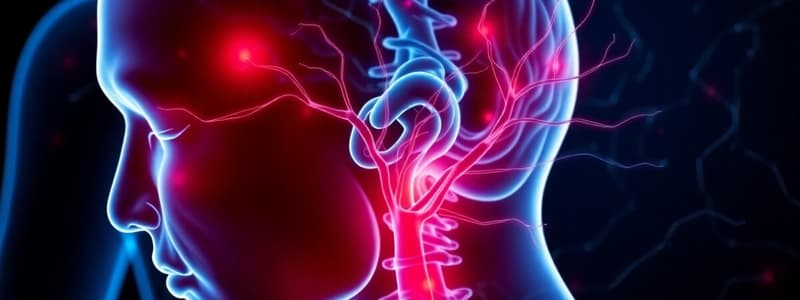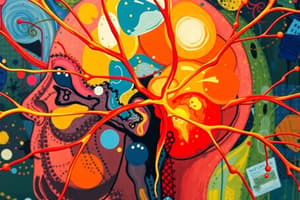Podcast
Questions and Answers
How does acute pain function in relation to tissue damage?
How does acute pain function in relation to tissue damage?
- It causes numbness to the affected area.
- It acts as a warning sign of danger. (correct)
- It has no physiological role.
- It indicates permanent damage to the tissue.
What is a characteristic of inflammatory pain?
What is a characteristic of inflammatory pain?
- It occurs without any tissue damage.
- It is triggered by noxious stimuli only.
- It results in the release of inflammatory mediators. (correct)
- It is always chronic in nature.
What distinguishes neuropathic pain from other types of pain?
What distinguishes neuropathic pain from other types of pain?
- It results solely from physical injury to the skin.
- It is characterized by sharp, stabbing sensations.
- It is caused by damage to nociceptive nerves. (correct)
- It only occurs in response to psychological triggers.
Which of the following correctly describes nociceptors?
Which of the following correctly describes nociceptors?
How do NSAIDs help alleviate inflammatory pain?
How do NSAIDs help alleviate inflammatory pain?
What is the primary function of TRPV1 in nociceptors?
What is the primary function of TRPV1 in nociceptors?
Which of the following statements about TRPV1 antagonists is true?
Which of the following statements about TRPV1 antagonists is true?
What is the role of ASIC channels in nociception?
What is the role of ASIC channels in nociception?
What is a notable property of mambalgins derived from black mamba venom?
What is a notable property of mambalgins derived from black mamba venom?
Which TRP channel is primarily activated by cold temperatures?
Which TRP channel is primarily activated by cold temperatures?
Which neurotransmitter is primarily released by nociceptive axons during moderate pain transmission?
Which neurotransmitter is primarily released by nociceptive axons during moderate pain transmission?
What is the role of the cingulate cortex in pain perception?
What is the role of the cingulate cortex in pain perception?
What substance do nociceptive axons release along with glutamate to transmit stronger pain signals?
What substance do nociceptive axons release along with glutamate to transmit stronger pain signals?
How do opioids function in the descending pain control circuit?
How do opioids function in the descending pain control circuit?
Which of the following drugs is a sodium channel blocker used in pain management?
Which of the following drugs is a sodium channel blocker used in pain management?
What role do local inhibitory interneurons serve in pain transmission?
What role do local inhibitory interneurons serve in pain transmission?
Which type of antidepressants is noted for treating neuropathic pain?
Which type of antidepressants is noted for treating neuropathic pain?
During strong pain transmission, which additional substance is released along with glutamate?
During strong pain transmission, which additional substance is released along with glutamate?
What is the primary function of descending pain control fibers?
What is the primary function of descending pain control fibers?
Ziconotide, used in pain management, acts as a blocker for which type of channels?
Ziconotide, used in pain management, acts as a blocker for which type of channels?
Flashcards
Nociception
Nociception
The process of detecting harmful stimuli, including normal processing of pain and responses to damaging stimuli.
Nociceptors
Nociceptors
Specialized nerve endings detecting potentially harmful stimuli.
Acute Pain
Acute Pain
Physiological pain response warning of danger.
Inflammatory Pain
Inflammatory Pain
Signup and view all the flashcards
Neuropathic Pain
Neuropathic Pain
Signup and view all the flashcards
TRPV1 receptor
TRPV1 receptor
Signup and view all the flashcards
TRPM8 receptor
TRPM8 receptor
Signup and view all the flashcards
ENaC/Degenerin family
ENaC/Degenerin family
Signup and view all the flashcards
ASIC ion channel
ASIC ion channel
Signup and view all the flashcards
Mamba venom analgesics
Mamba venom analgesics
Signup and view all the flashcards
Pain Pathway
Pain Pathway
Signup and view all the flashcards
Cingulate Cortex
Cingulate Cortex
Signup and view all the flashcards
Descending Pain Control
Descending Pain Control
Signup and view all the flashcards
Opioids
Opioids
Signup and view all the flashcards
Spinal Cord Pain Transmission
Spinal Cord Pain Transmission
Signup and view all the flashcards
Glutamate/Substance P
Glutamate/Substance P
Signup and view all the flashcards
Inhibitory Interneurons
Inhibitory Interneurons
Signup and view all the flashcards
Descending Opioid Release
Descending Opioid Release
Signup and view all the flashcards
Noradrenergic/Serotonergic
Noradrenergic/Serotonergic
Signup and view all the flashcards
Carbamazepine
Carbamazepine
Signup and view all the flashcards
Study Notes
Introduction to Pain
- Pain is a subjective response to a noxious stimulus.
- Sensation is nociception
- Nociceptors are free nerve endings.
Sensory System
- Sensory receptors include mechanoreceptors, thermoreceptors, chemoreceptors, and proprioceptors.
- Nociceptors detect noxious stimuli, like pain, itch, and temperature (cold or warmth).
- Sensory system transmits information to the spinal cord and then to sensory areas in the brain.
Different Kinds of Pain
- Acute pain (physiological) is a response to threats, normally lasting less than three months.
- Inflammatory pain (pathological) is caused by tissue damage like inflammation.
- Neuropathic pain is a result of injury to the nerves causing a burning sensation and increased sensitivity in affected areas
Acute Pain
- Acute pain is a physiological response warning of danger.
- Nociception is the normal processing of pain responses to noxious stimuli, which can be damaging or potentially damaging to normal tissue.
Inflammatory Pain
- Tissue damage releases inflammatory mediators like prostaglandins and bradykinin.
- This increases the sensitivity of nociceptors to noxious stimuli.
- Hyperalgesia is increased sensitivity to a noxious stimulus; allodynia is when a non-noxious stimulus causes the sensation of pain.
- NSAIDs reduce prostaglandin production.
Neuropathic Pain
- Neuropathic pain is caused by damage or injury to nociceptive nerves.
- Pain may be described as burning, and affected areas are often sensitive to touch.
- Types include post-amputation pain (stump and phantom pain), trigeminal neuralgia, painful radiculopathy, central post-stroke pain, postherpetic neuralgia, painful polyneuropathy, or peripheral nerve injury pain.
Nociceptors
- Nociceptors are free nerve endings in the skin, acting as molecular transducers to depolarize nerve cells.
- They are activated by various stimuli and trigger nociceptive impulses.
- Activated ion channels in nociceptors are commonly blocked by local anaesthetics like lidocaine.
- Many stimuli can activate ion channels in nociceptor terminals.
Signal transduction in Nociceptors
- TRPV1 is activated by noxious heat and is involved in pain transmission.
- TRPM8 is activated by cold and is also involved in pain transmission.
- CMR1 is activated by mechanical stimuli and is involved in pain transmission.
- ENaC/Degenerin family receptors are activated by mechanical stimuli and involved in pain transmission.
- ASICs are acid-sensing ion channels.
ASICs - Mamba Venom
- Mamba venom contains dendrotoxins, including dendrotoxin-k, -1, -3, and -7), and mambalgins, which are potent analgesics as strong as morphine without most side effects.
- These toxins block acid-sensing ion channels.
The Pain Pathway
- Pain perception occurs when neural signals are transmitted to higher-order brain areas.
- Cingulate cortex mediates the emotional component of pain.
- Other brain stem and cortical sites manage pain-related behaviors and vocalizations
Descending Pain Control Circuit
- Opiates decrease pain by modulating the pain pathway, such as the periaqueductal gray, the nucleus raphe magnus, and the lateral tegmental nuclei.
- Opioid use involves inhibitory and excitatory synapses, affecting noradrenergic and serotonergic neurons.
Pain Transmission in the Spinal Cord
- Nociceptive axons synapse with second-order neurons in lamina I, II, and V of the dorsal spinal horn.
- Moderate pain involves glutamate release, while stronger pain involves glutamate, substance P, and ATP release.
- Local inhibitory interneurons release GABA and glycine.
Analgesic Ladder
- Mirrors the pain pathway
- Step 1: Non-opioid analgesics (e.g., aspirin, paracetamol).
- Step 2: Mild opioids (e.g., codeine) with or without non-opioids.
- Step 3: Strong opioids (e.g., morphine) with or without non-opioids.
Opioids
- Opioid encompasses all drugs that act on opioid receptors - synthetic, semi-synthetic, or naturally occurring.
- Opiates are a subset of opioids, either derived directly from poppy or synthesized from one.
Opioid Receptors
- Endogenous opioids include dynorphins, enkephalins, endorphins, and endomorphins.
- G protein-coupled receptors with opioid ligands include μ opioid receptors (MORs), activated by morphine and enkephalins; δ opioid receptors (DORs), activated by enkephalins; and κ opioid receptors (KORs), activated by dynorphins.
- Receptor activation opens potassium channels, making neurons less excitable, and inhibits calcium channels, reducing neurotransmitter release
Opiate Addiction
- Opiates affect areas of the brain responsible for reward, such as the limbic system and dopamine reward centers.
- This action affects emotions and causes feelings of pleasure.
- Opiates might also block pain signals transmitted via the spinal cord to the brain.
Tolerance and Desensitization
- Repeated opioid use can lead to decreased effectiveness in pain relief due to receptor desensitization.
- Repeated opioid treatment leads to less pain relief because the receptors become less responsive.
Peripheral Effects
- Opiates can decrease GI motility, increase anal sphincter tone, and reduce rectal distention reflex.
- They also affect urinary bladder function, decreasing the reflex for voiding.
Some Opioids
- Diamorphine (heroin): highly lipid-soluble, acts quickly, and deacetylates to morphine.
- Codeine: a weak opioid with 20% efficacy compared to morphine; commonly used for mild pain.
- Nalorphine: an opioid antagonist used for reversing opioid effects.
- Naloxone: an opioid antagonist, orally active, and longer-lasting for opioid overdoses.
- Pethidine: structurally similar to morphine but can induce restlessness and possible hallucinogenic/convulsant effect.
- Methadone: longer-acting than morphine, used in opioid addiction treatment.
Studying That Suits You
Use AI to generate personalized quizzes and flashcards to suit your learning preferences.




